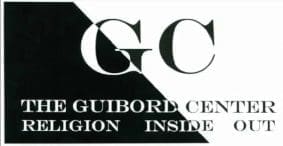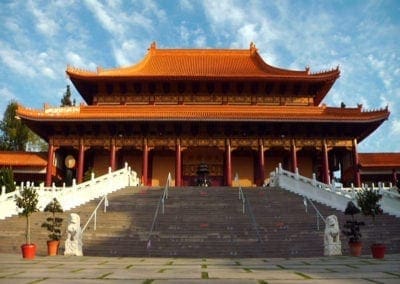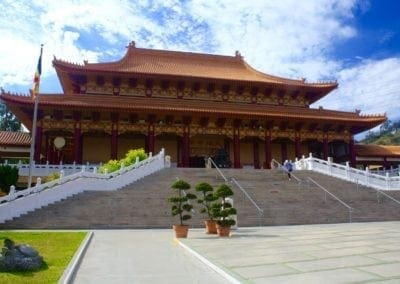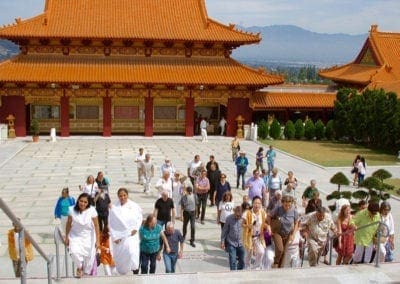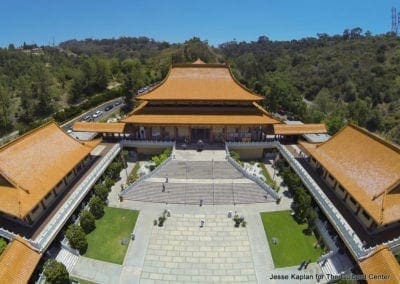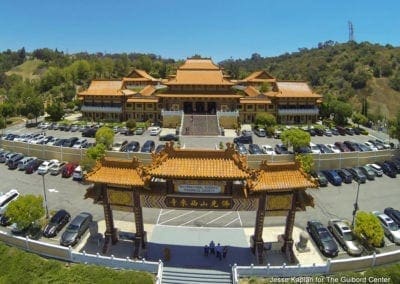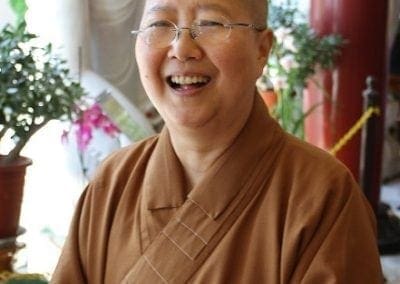Buddhist Sacred Texts
The Lotus Sutra at Hsi Lai Temple
Part 1: The Temple
by Dr. Lo Sprague
You don’t see it coming. One moment you are driving through a quiet town and two twists later you have arrived at the foot of a vast temple complex somewhere deep in the heart of China. On one side is the heavy triple-arched gate several stories high that welcomes people to the Temple and on the other a stone staircase dozens of steps high leading up to the Bodhisattva Hall that towers above you. Climbing the stairs, one begins to catch sight of the enormous carved figure up at the very top, looking down and smiling upon people bowing or kneeling before him. (There is an elevator tucked away discreetly for those who need it.)
One is struck first by the sheer size of the five Bodhisattva figures that command the space. The center statue is of The Great Benevolence of Maitreya Bodhisattva seated on a golden lotus. He is warm, inviting, calming, and compassionate. He is joined on either side by Bodhisattvas who sit more formally on various creatures.
The senses are awakened immediately by the dimensions of the Hall and then by the colors that fill it. Simple elegant flower arrangements are placed on the tables at the foot of the great statues. Fresh fruit and neatly folded sets of clothing are laid beside them along with teas and food and the six other offerings appropriate for showing respect and gratitude to these great Beings.
Many first-time visitors make the same mistake. They come here to stand or bow or kneel, praying and paying their respects quietly, and then they turn to descend the stairs and leave – never realizing that this space, as wondrous as it is, is not the main Temple but the entrance to the Temple. The complex is huge with magnificent gardens, assembly halls, an auditorium, classrooms, a museum, a tea room/ bookstore, a dining hall that feeds hundreds of people a day, a memorial pagoda, a school, an international translation center, and the Main Shrine all housed within the stunning architecture of a working temple in the style of ancient China.
The Guibord Center’s visitors to Buddhist Sacred Texts 101 are saved from that mistake as Rev. Dr. Gwynne Guibord and Venerable Miao Hsi welcome them right at the top of the steps. After a few quiet moments in the sacred space colleagues escort us through the passages on either side of the Hall out into the main courtyard teeming with sunlight, serenity, and the joyful sounds of children. Buddha’s Light Children’s Summer Camp is in full session. The counselors and children alike appear blissfully unbothered by visitors walking nearby.
Elaborately carved statues line the walkways that border the courtyard. Each figure has a sign in English nearby telling its unique story. Across the large open area stands the Main Hall, at the heart of the magnificent architecture of the complex atop a wide staircase.
We are invited to wander freely amid the statuary, enjoy the pleasant gardens and calm pools, and explore the peaceful grounds at our leisure until everyone has arrived.
Once our group of nearly fifty is complete, Miao Hsi lays out the course of the morning. We will follow her across the courtyard and up the stairs into the Main Temple where we will join others already there in the chanting of the Lotus Sutra. While the others remain, we will return to our designated classroom where she will then explain the Sutra and invite our questions.
Off we go to explore an ancient world new to many of us. There is excitement in the air. People laugh as they climb the steps and turn to take in the amazing view of the valley out over the rooftops. They marvel together and extend their arms to introduce themselves to one another.
This Temple Hall feels entirely different from the first. The Main Hall houses “10,000 Buddhas” that encircle the entire room. They are small and set in individual alcoves in lines in almost every foot of every wall. They are staggering in the sheer magnitude of their presence. Three Enormous Golden Buddhas rise against the wall we approach. The face of each is illuminated. Light bouncing off the crystals of the huge lantern hanging down from the ceiling and from the illumination of the Buddhas interweaves with the smaller Buddhas to overwhelm the senses. The effect is truly stunning.
We have each been handed a book as we entered the hall. As we line up close to one another, a female monk points out the place where English is beneath the foreign print. One tries to follow the fast pace of the chanting set by a monk striking a gigantic carved wooden fish. The chanting moves quickly and takes great concentration to follow. Another monk keeps time on a more traditional drum.
There is little choice but to give oneself over to the chant. It sweeps you up. The words seem odd. There is no time for logic to scrutinize – only the steady stream of sounds. At some point, one gives up the western mind and flows with the sound. We stand. We chant. Some people close their eyes and let it wash over them. Some sit. The monks who move among us are kind. They gently point us back to the correct page and place. They ask if we are okay standing. They smile. Time stands still with us, and suddenly we have reached the end.
We flow out of the Main Hall and follow Miao Hsi down a side staircase back to a comfortable modern classroom on the main level. Here she will offer a wonderful exploration of the portion of the Sutra we have just all chanted together. Once she finishes and answers all our questions, she will lead us to the main dining room where we will partake in the delicious vegan lunch recommended gloriously by many regular visitors to the temple.
First, however, we will feast on sustenance of a different kind, food for the soul, from the chapter of the Lotus Sutra we have just chanted together in the Temple above us.
